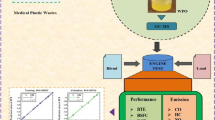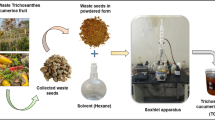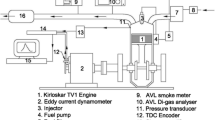Abstract
This study is about soot emission prediction of a waste-gated turbo-charged DI diesel engine using artificial neural network (ANN). For training the ANN model, six ranges of experimental data in previous study were used, and one range of data was kept for testing the accuracy of ANN predictions. The input parameters for the ANN are inlet manifold pressure, inlet manifold temperature, inlet air mass flow rate, fuel consumption, engine torque, and speed. Output parameter is the density of soot in the exhaust. The results show the ANN approach can be used to accurately predict soot emission of a turbo-charged diesel engine in different opening ranges of waste-gate (ORWG). Root mean-squared error (RMSE), fraction of variance (R 2), and mean absolute percentage error (MAPE) for predictions were found to be 1.19 (mg/m3), 0.9998, and 6.4%, respectively.








Similar content being viewed by others
Abbreviations
- ANN:
-
Artificial neural network
- C f :
-
Power correction factor
- Eq. ratio:
-
Equivalence ratio
- LM:
-
Levenberg–Marquardt
- MAPE:
-
Mean absolute percentage error
- MLP:
-
Multilayer perceptron
- \( \dot{m}_{\text{f}} \) :
-
Fuel mass flow rate
- \( \dot{m}_{\text{soot}} \) :
-
Soot mass flow rate
- N:
-
Engine speed
- ORWG:
-
Opening range of waste gate
- P b,s :
-
Engine brake power
- P exhaust :
-
Exhaust pressure
- P in :
-
Inlet manifold pressure
- RMSE:
-
Root mean-squared error
- R 2 :
-
Fraction of variance
- SCG:
-
Scaled conjugate gradient
- T:
-
Engine torque
- T exhaust :
-
Exhaust temperature
- T 0 :
-
Ambient temperature
- ρsoot :
-
Exhaust soot density
References
George S, Balla S, Gautam V, Gautam M (2007) Effect of diesel soot on lubricant oil viscosity. USA J Tribol Int 40:809–818
Tree DR, Svensson KI (2007) Soot processes in compression ignition engines. Progr Energy Combust Sci 33:272–309
Pickett LM, Siebers DL (2003) Soot in diesel fuel jets: effect of ambient temperature, ambient density, and injection pressure. Combust Flame 138:114–135
Ghazikhani M, Davarpanah M, Moosavi Shayegh SA (2008) An experimental study on the effects of different opening ranges of waste-gate on the exhaust soot emission of a turbo-charged DI diesel engine. Energy Convers Manag 49:2563–2569
Haykin S (1999) Neural networks a comprehensive foundation. Prentice Hall, Englewood Cliffs
Yuanwang D, Meilin Z, Dong X, Xiaobei C (2002) An analysis for effect of cetane number on exhaust emissions from engine with the neural network. Fuel 81:1963–1970
Çelik V, Arcaklioglu E (2005) Performance maps of a diesel engine. Appl Energy 81:247–259
Durán A, Lapuerta M, Rodríguez-Fernández J (2005) Neural networks estimation of diesel particulate matter composition from transesterified waste oils blends. Fuel 84:2080–2085
Gölcü M, Sekmen Y, Erduranlı P, Sahir Salman M (2005) Artificial neural-network based modeling of variable valve-timing in a spark-ignition engine. Appl Energy 81:187–197
Canakci M, Erdil A, Arcaklioğlu E (2006) Performance and exhaust emissions of a biodiesel engine. Appl Energy 83:594–605
Sayin C, Metin Ertunc H, Hosoz M, Kilicaslan I, Canakci M (2007) Performance and exhaust emissions of a gasoline engine using artificial neural network. Appl Therm Eng 27:46–54
Atashkari K, Nariman-Zadeh N, Gölcü M, Khalkhali A, Jamali A (2007) Modelling and multi-objective optimization of a variable valve-timing spark-ignition engine using polynomial neural networks and evolutionary algorithms. Energy Conserv Manag 48:1029–1041
Ashhab MSS (2008) Fuel economy and torque tracking in camless engines through optimization of neural networks. Energy Conserv Manag 49:365–372
Hu YH, Hwang J-N (2001) Handbook of neural network signal processing. CRC Press, New York
Hagan MT, Demuth HB, Beale M (2002) Neural network design. China Machine Press, China
Beale R, Jackson T (1998) Neural computing: an introduction. Institute of Physics Publishing, Bristol
Author information
Authors and Affiliations
Corresponding author
Rights and permissions
About this article
Cite this article
Ghazikhani, M., Mirzaii, I. Soot emission prediction of a waste-gated turbo-charged DI diesel engine using artificial neural network. Neural Comput & Applic 20, 303–308 (2011). https://doi.org/10.1007/s00521-010-0500-7
Received:
Accepted:
Published:
Issue Date:
DOI: https://doi.org/10.1007/s00521-010-0500-7




